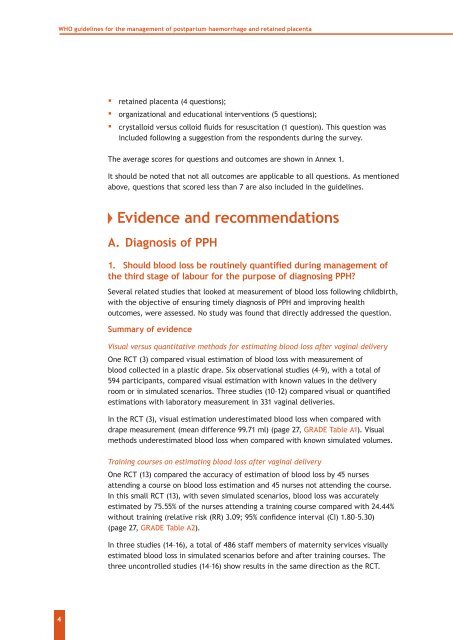WHO guidelines for the management of postpartum haemorrhage ...
WHO guidelines for the management of postpartum haemorrhage ...
WHO guidelines for the management of postpartum haemorrhage ...
Create successful ePaper yourself
Turn your PDF publications into a flip-book with our unique Google optimized e-Paper software.
<strong>WHO</strong> <strong>guidelines</strong> <strong>for</strong> <strong>the</strong> <strong>management</strong> <strong>of</strong> <strong>postpartum</strong> <strong>haemorrhage</strong> and retained placenta<br />
▪ retained placenta (4 questions);<br />
▪ organizational and educational interventions (5 questions);<br />
▪ crystalloid versus colloid fluids <strong>for</strong> resuscitation (1 question). This question was<br />
included following a suggestion from <strong>the</strong> respondents during <strong>the</strong> survey.<br />
The average scores <strong>for</strong> questions and outcomes are shown in Annex 1.<br />
It should be noted that not all outcomes are applicable to all questions. As mentioned<br />
above, questions that scored less than 7 are also included in <strong>the</strong> <strong>guidelines</strong>.<br />
Evidence and recommendations<br />
A. Diagnosis <strong>of</strong> PPH<br />
1. Should blood loss be routinely quantified during <strong>management</strong> <strong>of</strong><br />
<strong>the</strong> third stage <strong>of</strong> labour <strong>for</strong> <strong>the</strong> purpose <strong>of</strong> diagnosing PPH?<br />
Several related studies that looked at measurement <strong>of</strong> blood loss following childbirth,<br />
with <strong>the</strong> objective <strong>of</strong> ensuring timely diagnosis <strong>of</strong> PPH and improving health<br />
outcomes, were assessed. No study was found that directly addressed <strong>the</strong> question.<br />
Summary <strong>of</strong> evidence<br />
Visual versus quantitative methods <strong>for</strong> estimating blood loss after vaginal delivery<br />
One RCT (3) compared visual estimation <strong>of</strong> blood loss with measurement <strong>of</strong><br />
blood collected in a plastic drape. Six observational studies (4–9), with a total <strong>of</strong><br />
594 participants, compared visual estimation with known values in <strong>the</strong> delivery<br />
room or in simulated scenarios. Three studies (10–12) compared visual or quantified<br />
estimations with laboratory measurement in 331 vaginal deliveries.<br />
In <strong>the</strong> RCT (3), visual estimation underestimated blood loss when compared with<br />
drape measurement (mean difference 99.71 ml) (page 27, GRADE Table A1). Visual<br />
methods underestimated blood loss when compared with known simulated volumes.<br />
Training courses on estimating blood loss after vaginal delivery<br />
One RCT (13) compared <strong>the</strong> accuracy <strong>of</strong> estimation <strong>of</strong> blood loss by 45 nurses<br />
attending a course on blood loss estimation and 45 nurses not attending <strong>the</strong> course.<br />
In this small RCT (13), with seven simulated scenarios, blood loss was accurately<br />
estimated by 75.55% <strong>of</strong> <strong>the</strong> nurses attending a training course compared with 24.44%<br />
without training (relative risk (RR) 3.09; 95% confidence interval (CI) 1.80–5.30)<br />
(page 27, GRADE Table A2).<br />
In three studies (14–16), a total <strong>of</strong> 486 staff members <strong>of</strong> maternity services visually<br />
estimated blood loss in simulated scenarios be<strong>for</strong>e and after training courses. The<br />
three uncontrolled studies (14–16) show results in <strong>the</strong> same direction as <strong>the</strong> RCT.<br />
4
















